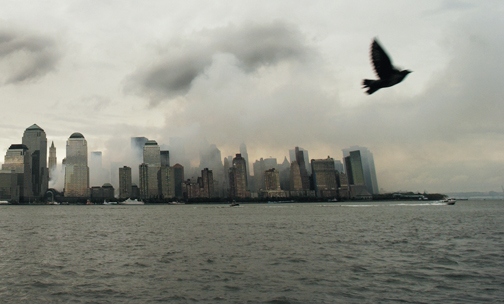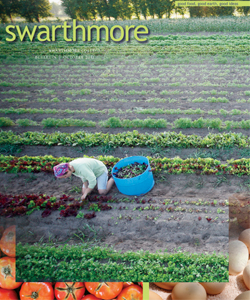Post–9/11: A Compassionate World, a More Secure World

Ten years after the attacks on the World Trade Center, the campus community came together to discuss nonviolent conflict resolution and remember the loss of life caused by the terrorist attacks.
Ten years after the attacks on the World Trade Center, the College held a series of campus events that commemorated the tragedy and emphasized nonviolent resistance against terrorism.
On Sunday, Sept. 11, students, staff, and community members gathered at Friends Meeting House for a period of silent reflection and remembrance in the Quaker tradition. Students from different religious traditions offered Buddhist, Jewish, and Christian prayers that each evoked the central theme of finding peace in times of discord and conflict. Participants decorated and wrote personal reflections of 9/11 on prayer flags, which were later placed in the Shane Lounge in Parrish Hall.
Junior Quitterie Gounot described the memorial service as “subdued” and “reflective” but overwhelmingly positive.”
According to Gounot, the Quaker tradition of community was “particularly well suited to the occasion,” encouraging everyone to come together at a vulnerable time when “our values, our sense of collective and individual identity, and our feeling of safety are challenged or threatened.”
In her remarks (watch), President Rebecca Chopp spoke about first finding a “discipline of self” before embarking on a “journey of peace” and healing in today’s post-9/11 age.
Associate Professor of Sociology Lee Smithey and Assistant Professor of Statistics Lynne Steuerle Schofield ’99 gave moving speeches that appealed to the vision of a more “equitable” and “compassionate” world. Scholfield’s mother was a passenger on the American Airlines flight that crashed into the Pentagon. (The lone casualty among Swarthmore alumni that day was Jonathan Randall ’82, who died on the 95th floor of the North Tower of the World Trade Center.)
Schofield pointed out that the focus on our own victimization has bred even more hatred in the wake of grief and tragedy.
“Hatred cannot be an enduring response,” Schofield said, adding that what she will always remember about the dark period following her mother’s death is the “network of rebuilders” that served as her essential emotional and moral support. But even more easily, she recalls the “compassionate response” in the numerous social works that arose around the families of the 9/11 victims.
Smithey referred to the “resilience of these families,” enabling them to “channel their grief into programs at a social level.” According to Schofield and Smithey, keeping a sense of social initiative alive helps the community to move on from its collective grief. Instead of building on grief, people should start to refocus their energies toward participating in concrete, empowering social activism for the long-term good of the community.
Smithey and Schofield as well as Visiting Professor of Peace and Conflict Studies George Lakey, who is also a research fellow of the Lang Center for Civic and Social Responsibility, explored the specific nature and values of this form of activism at a teach-in on nonviolent resistance the following day. Focusing on the question of the strategic potential of nonviolent campaigns against state terrorism, they pointed out that, statistically, nonviolent campaigns are 53 percent more successful than violent means in achieving their causes.
Lakey drew on the example of Norway after its recent terrorist incident, after which Norwegians “reasserted core Norwegian values of openness, democracy, and tolerance” instead of resorting to the violence and paranoia that pervaded post-9/11 American society.
“True security comes from making a more compassionate world,” Schofield reasserted, emphasizing that individuals should start from the micro level to contribute to a greater vision of peace in the world community.
Other events in honor of the anniversary involved a panel discussion about the lasting impact of media coverage around Sept. 11, and the official launch of Lakey’s Global Nonviolent Action Database.
—Maki Somosot ’12
 Email This Page
Email This Page